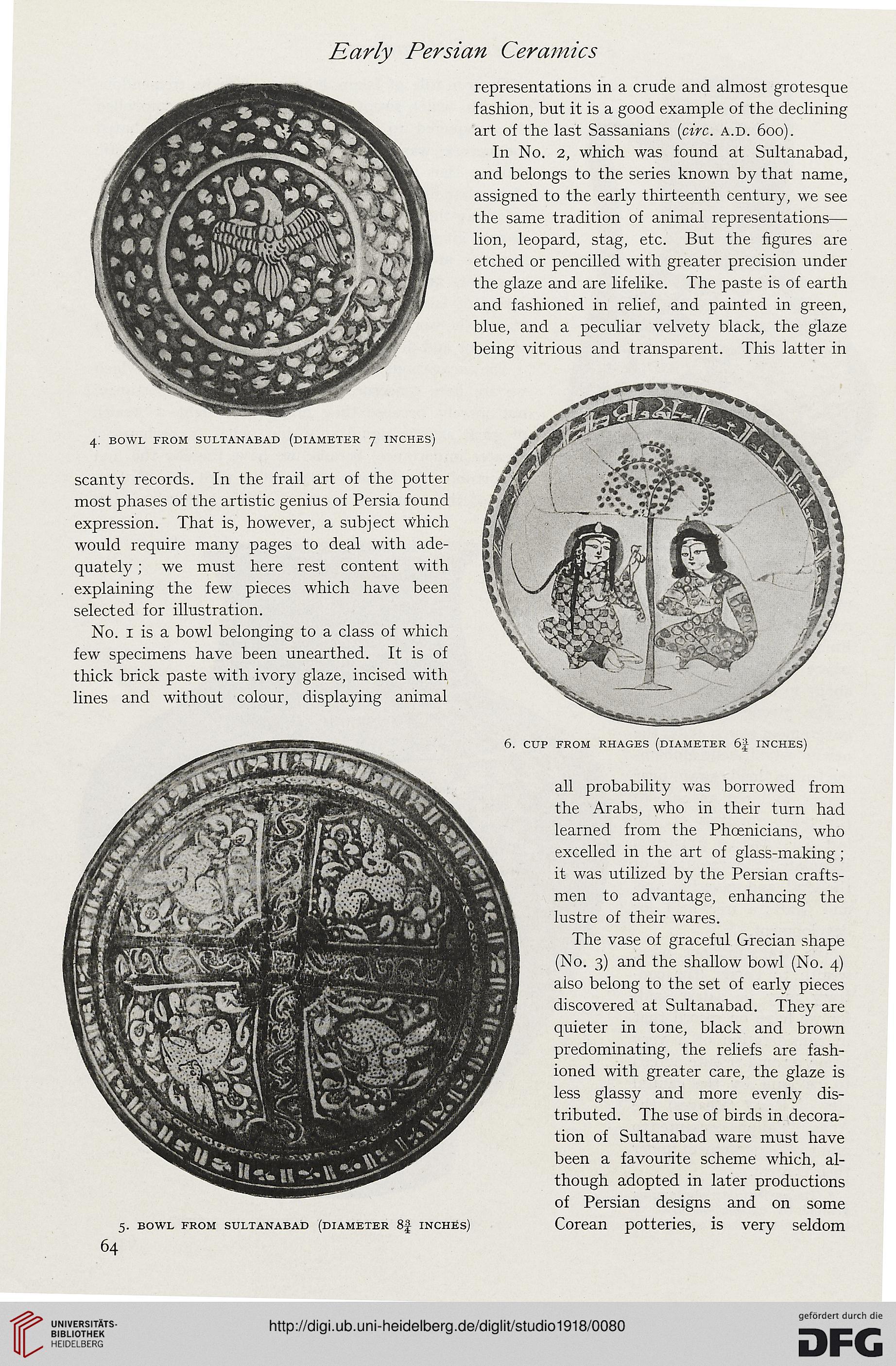Early Persian Ceramics
4. BOWL FROM SULTANABAD (DIAMETER 7 INCHES)
scanty records. In the frail art of the potter
most phases of the artistic genius of Persia found
expression. That is, however, a subject which
would require many pages to deal with ade-
quately ; we must here rest content with
explaining the few pieces which have been
selected for illustration.
No. 1 is a bowl belonging to a class of which
few specimens have been unearthed. It is of
thick brick paste with ivory glaze, incised with
lines and without colour, displaying animal
representations in a crude and almost grotesque
fashion, but it is a good example of the declining
art of the last Sassanians (circ. a.d. 600).
In No. 2, which was found at Sultanabad,
and belongs to the series known by that name,
assigned to the early thirteenth century, we see
the same tradition of animal representations—
lion, leopard, stag, etc. But the figures are
etched or pencilled with greater precision under
the glaze and are lifelike. The paste is of earth
and fashioned in relief, and painted in green,
blue, and a peculiar velvety black, the glaze
being vitrious and transparent. This latter in
CUP
5. BOWL FROM SULTANABAD (DIAMETER 8f INCHES)
FROM RHAGES (DIAMETER 6J INCHES)
all probability was borrowed from
the Arabs, who in their turn had
learned from the Phoenicians, who
excelled in the art of glass-making;
it was utilized by the Persian crafts-
men to advantage, enhancing the
lustre of their wares.
The vase of graceful Grecian shape
(No. 3) and the shallow bowl (No. 4)
also belong to the set of early pieces
discovered at Sultanabad. They are
quieter in tone, black and brown
predominating, the reliefs are fash-
ioned with greater care, the glaze is
less glassy and more evenly dis-
tributed. The use of birds in decora-
tion of Sultanabad ware must have
been a favourite scheme which, al-
though adopted in later productions
of Persian designs and on some
Corean potteries, is very seldom
64
4. BOWL FROM SULTANABAD (DIAMETER 7 INCHES)
scanty records. In the frail art of the potter
most phases of the artistic genius of Persia found
expression. That is, however, a subject which
would require many pages to deal with ade-
quately ; we must here rest content with
explaining the few pieces which have been
selected for illustration.
No. 1 is a bowl belonging to a class of which
few specimens have been unearthed. It is of
thick brick paste with ivory glaze, incised with
lines and without colour, displaying animal
representations in a crude and almost grotesque
fashion, but it is a good example of the declining
art of the last Sassanians (circ. a.d. 600).
In No. 2, which was found at Sultanabad,
and belongs to the series known by that name,
assigned to the early thirteenth century, we see
the same tradition of animal representations—
lion, leopard, stag, etc. But the figures are
etched or pencilled with greater precision under
the glaze and are lifelike. The paste is of earth
and fashioned in relief, and painted in green,
blue, and a peculiar velvety black, the glaze
being vitrious and transparent. This latter in
CUP
5. BOWL FROM SULTANABAD (DIAMETER 8f INCHES)
FROM RHAGES (DIAMETER 6J INCHES)
all probability was borrowed from
the Arabs, who in their turn had
learned from the Phoenicians, who
excelled in the art of glass-making;
it was utilized by the Persian crafts-
men to advantage, enhancing the
lustre of their wares.
The vase of graceful Grecian shape
(No. 3) and the shallow bowl (No. 4)
also belong to the set of early pieces
discovered at Sultanabad. They are
quieter in tone, black and brown
predominating, the reliefs are fash-
ioned with greater care, the glaze is
less glassy and more evenly dis-
tributed. The use of birds in decora-
tion of Sultanabad ware must have
been a favourite scheme which, al-
though adopted in later productions
of Persian designs and on some
Corean potteries, is very seldom
64




